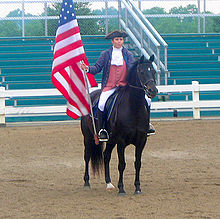Morgan horse
[1] Tracing back to the foundation sire Figure, later named Justin Morgan after his best-known owner, Morgans served many roles in 19th-century American history, being used as coach horses and for harness racing, as general riding animals, and as cavalry horses during the American Civil War on both sides of the conflict.
During the 19th and 20th centuries, they were exported to other countries, including England, where a Morgan stallion influenced the breeding of the Hackney horse.
Compact and refined in build, the Morgan has strong legs, an expressive head with a straight or slightly convex profile and broad forehead; large, prominent eyes; well-defined withers, laid back shoulders, and an upright, well arched neck.
Less common colors include gray, roan, dun, silver dapple, and cream dilutions such as palomino, buckskin, cremello and perlino.
MCOA is characterized by the abnormal development of some ocular tissues, which causes compromised vision, although generally of a mild form; the disease is non-progressive.
[11] All Morgans trace back to a single foundation sire, a stallion named Figure, who was born in West Springfield, Massachusetts in 1789.
One historian notes that the writings on the possibility of his sire being a Thoroughbred named Beautiful Bay would "fill 41 detective novels and a membership application for the Liars' Club.
Best known was Sherman, another chestnut stallion, slightly shorter than Figure, who in turn was the sire and grandsire of Black Hawk and Ethan Allen.
Black Hawk, born in 1833, went on to become a foundation stallion for the Standardbred, American Saddlebred and Tennessee Walking Horse breeds, and was known for his unbeaten harness racing record.
Miners in the California Gold Rush (1848–1855) used the breed, as did the Army during and after the American Civil War for both riding and harness horses.
[13] Daniel Chipman Linsley, a native of Middlebury, Vermont, compiled a book of Morgan breeding stallions, published in 1857.
Colonel Joseph Battell, also a Middlebury, Vermont native, published the first volume of the Morgan Horse Register in 1894, marking the beginning of a formal breed registry.
[17] The breeding program aimed to produce horses that were sound, sturdy, well-mannered, and capable of performing well either under saddle or in harness.
[24] The University of Kansas Natural History Museum, which has the stuffed body of Comanche on display, makes no statement as to his breed.
[25] There are four main bloodlines groups within the Morgan breed today, known as the Brunk, Government, Lippitt, and Western Working "families."
[1] When USDA involvement ended, the University of Vermont purchased not only the farm,[20] but much of its breeding stock and carries on the program today.
It is estimated that between 175,000 and 180,000 Morgans exist worldwide, and although they are most popular in the United States, there are populations in Great Britain, Sweden and other countries.
In addition to the AMHA, since 1996, there has also been a National Morgan Pony Registry, which specializes in horses under 14.2 hands (58 inches, 147 cm).
There are also associations for Morgans in several countries besides the US, including Canada, Australia, New Zealand, Great Britain, Sweden, Austria and Germany.
They have been successfully shown in many disciplines, including dressage, show jumping, Western pleasure, cutting and endurance riding.
They can be seen as mounts for 4-H and Pony Club participants and therapeutic riding programs, due to their gentle disposition and steady movement.
[43] Both the book and the movie have been criticized for containing a number of historical inaccuracies and for creating or perpetuating some myths about both Justin Morgan and Figure.
In the poem, the speaker observes "A little Morgan"[47] colt who has been left out in a mountain pasture during winter and seems to be afraid of the falling snow.






